Tomb Raider
by Kanishk Tharoor
While Hollywood gets more intimate with China’s studios and censors, the Met calls in state-approved partners for a blockbuster of ancient art. At the museum and at the multiplex, it’s tough to divide China’s past glories from the Party’s present aims

Kneeling archer from the mausoleum complex of Qinshihuang. Qin dynasty, 221–206 BC. Earthenware. 49 in. Qinshihuang Mausoleum Site Museum, Lintong, China.
All modern countries project themselves into the past, but some do it more insistently than others. The gargantuan National Museum of Anthropology in Mexico City is a place of marvels — Olmec stone heads, Oaxacan textiles — until it guides you into its heart, and reveals its political project: to subordinate the bewildering archaeological diversity of Mesoamerica in the exaltation of a single people, the Mexica (or Aztecs). Or consider Saudi Arabia, whose national petroleum company funded the show “Roads of Arabia,” which traced a tenuous path from eerie 6,000-year-old colossi to 3,000-year-old incense burners to the wardrobe and accessories, including swords and falconing gloves, of the Saudi patriarch, King Abdulaziz. The show went everywhere from the Louvre and the Pergamon to the Smithsonian and the Hermitage, and its historical and cultural contortions were unashamed. The exhibition sought to endow the Kingdom of Saudi Arabia — a basically arbitrary creation of the 20th century — with the deep continuity that only comes from the possession of antiquity.
China is admittedly different from Saudi Arabia, Mexico, and the many other states, from Turkey to South Africa, that enlist past artworks for present politics. For over 2,000 years, a series of astonishingly centralized polities has held sway over the Chinese mainland. That seeming continuity allows the Communist Party to insist that there has always been a clearly articulated entity called China, of which the People’s Republic, born in 1949, is the latest (and possibly final) manifestation. “Age of Empires,” a blockbuster exhibition of the art of the Qin and Han dynasties on view now in New York, visits a foundational moment in this national story. The Met has not mounted it alone. The exhibition marks the first major Sino-US collaboration of its kind, with the heavy involvement of China’s ministries of culture and foreign affairs, its governmental art agencies, and the substantial sponsorship of the China Merchants Bank — the first Chinese corporation to sponsor a Met show. It draws from 32 Chinese museums, many obscure, in 13 different provinces. Many of the objects are recent discoveries, unearthed in the last 20 years, and stand as evidence of China’s renewed commitment to the excavation and investigation of its antique past.
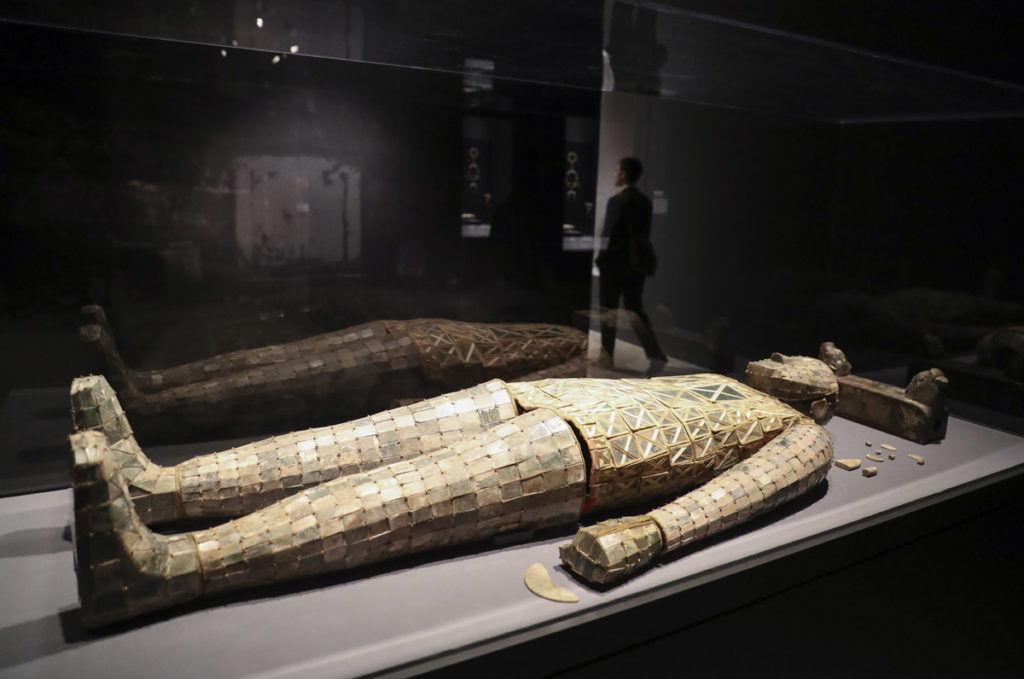
The 164 assembled objects narrate the formation of both a nation and a state: the coalescence in a 400-year period of what we now call China. The short-lived but hugely mythologized Qin dynasty (221–206 BC) yoked together previously fractious kingdoms under the rule of a single, august ruler. Qin-era relics include, most famously, the terracotta warriors buried en masse in the mausoleum of Qinshihuang, the ur-monarch who coined the Chinese word for “emperor.” Half a dozen of the 8,000-odd warriors have dutifully travelled from Xi’an to the Met. Although in situ they form an implacable collective, they were initially painted with unique features. The pigments have faded, but the diversity remains. The emperor didn’t only take soldiers with him into the afterlife. There were acrobats, dancers, sages, and even a now headless “strongman” entertainer, who looms over the initial part of the exhibition, his torso rippling rather endearingly with fat.
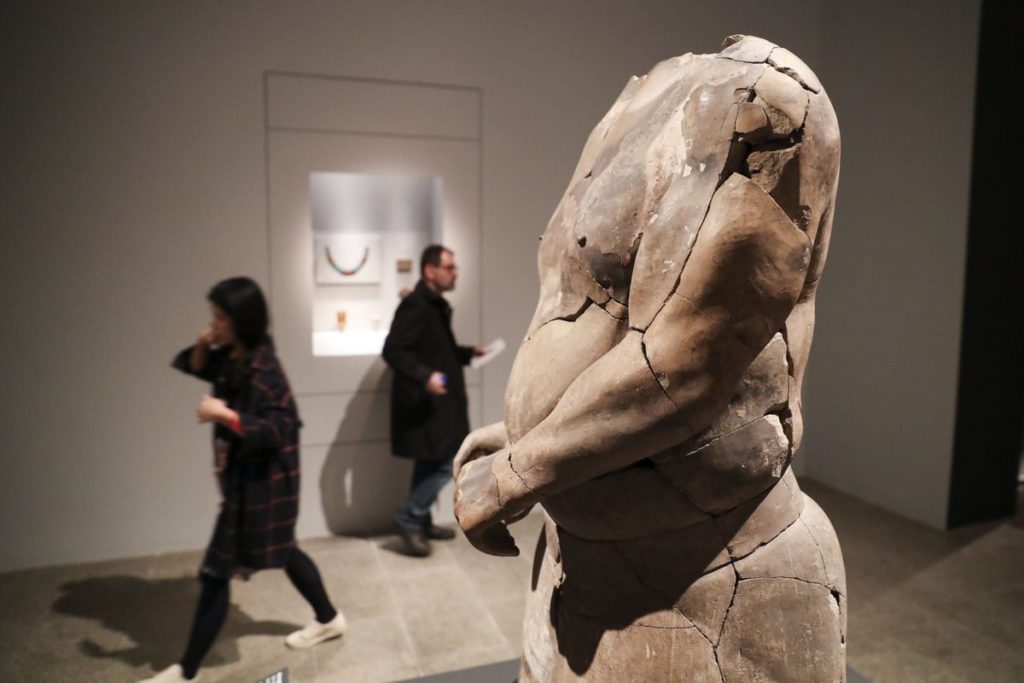
Site Museum, Lintong, China. From "Age of Empires."
Rulers of the Han dynasty (206 BC–AD 222), which consolidated and expanded the gains of the Qin, carried on the previous empire’s burial practice of proceeding to the hereafter in good company. “Age of Empires” offers a panoply of Han-era funerary sculptures, some bronze and some earthenware, including roosters, boars, a rhinoceros, an elephant, and a guard dog. At least in metaphor, an emperor preserved his omnipotence in death, bringing with him all the sundry creatures and people of his realm.
The great centralizing power of the state is, with good reason, a clear theme of the exhibition. Until the rise of the Ottoman Empire, the Qin, Han, and subsequent Chinese dynasties were unparalleled among pre-modern polities in how successfully they controlled vast spaces. Entombment may have preserved the more luxurious relics of the era, but it’s the most mundane ones that reveal the true ambitions of the two empires. In the midst of elegant bronze waterfowl (46 were buried in a Qin emperor’s tomb, as part of his afterlife food supply), a burial costume made entirely of jade, tiles with dragon motifs, and gold-inlaid swords, Met visitors could easily miss the innocuous weights and measures, rulers and water clocks that really cemented imperial power. With these, Qin and Han monarchs could standardize the collection of grain taxes, the fastidious minting of currency, the demarcation of plots of land and roads, the maintenance of reliable lines of communication, and even the recording of exact dates and times on all clerical correspondence. The sprawling bureaucracy of the Qin and Han Empires is the real star of the show. Its regimented, quotidian functioning enabled an immense project of conquest and rule.

“Age of Empires” is a show of emperors, soldiers, and bureaucrats; glimpses of the lives of ordinary people are almost entirely missing. (In this, it may not be too different from any other museum blockbuster, though the omnipresence of death — compounded by an exhibition design of black walls and targeted pin lights — makes this a more somber outing than most.) An exception can be found in a Han-era brick, about a foot and a half long and loaned from the Sichuan Provincial Museum in Chengdu, which depicts a rare, haunting scene of salt production. There is something disconsolate in the faded, humped forms of workers toiling over salt wells and evaporation pans, a submerged world straining to be seen through the rock.
When the exhibition strays from imperial pomp, it is to highlight the peaceable accretion of other cultures and places into the Chinese worldview. Parthian coins from Central Asia sit beside beaded necklaces from India, the distinct bronze-casting of southwestern China, and the pervasive motifs of the nomadic peoples forever shading the Chinese frontier as found in turquoise headdresses, gold belt buckles, and bronze ornaments for harnesses. Under the unsubtle subhead “One Nation, Many Cultures,” this last part of the exhibition depicts a multicultural empire, open to the world, stable and harmonious under the beneficent rule of its imperial autocrat.
There is no denying the remarkable forms of state centralization developed by the Qin and Han dynasties, nor the diversity of their subjects, nor the great scope of their trading networks. But the siren song of modern nationalist ideology is ever present. Whether intentionally or not, the show appears to parrot the public messaging of the current Chinese state in its insistence on the unbroken, immemorial continuity of Chinese governance, on a diverse body politic docile beneath the rule of law, and on a nation at peace with its neighbors and open for business. The dogged and recurring Chinese phenomenon of huge-scale rebellion, not to mention the constant suspicion and suppression of minority groups and religious sects, goes largely unmentioned here. Carved along the rim of a 2,000 year-old bronze mirror, which we find under a spotlight at the show’s end, is a blessing for the nation: “May the Central Kingdom [China] be peaceful and secure, and prosper for generations and generations to come, by following the great law that governs all.” This is an ancient sentiment, hardly unique to the modern Party: Confucian teachings also conceived of China as the center of the world. But placing this object in such dramatic circumstances, just before the gift shop, verges on agitprop. These are words that could still be easily proclaimed today, from the rostrum of the Great Hall of the People.

Despite the many aesthetic pleasures of “Age of Empires,” it remains freighted with this ideological baggage, the inevitable outcome of the investment and energies of the Chinese state. The Met now joins the ranks of the many art and entertainment institutions in China to turn to this period of Chinese history. Filmmakers, in particular, have for decades made Qin and Han-era China — and its preceding “Warring States” period — settings for martial arts epics known as wuxia. It’s a natural destination in the contemporary search for an origin story, for a time when the Chinese became Chinese. The most famous example of this genre is Hero (2002), by the big-ticket director Zhang Yimou, which turned heads in the west with its lush cinematography, kaleidoscopic costume design, and acrobatic choreography. Hero was an explicit mainland response to the worldwide success of Ang Lee’s Crouching Tiger, Hidden Dragon, which was Taiwanese — and the film Zhang made was at once seductive, breathtaking, and utterly appalling. After years of careful planning to assassinate Qinshihuang (of later terracotta warrior fame), the film’s protagonist, played by Jet Li, comes to the inspired revelation that he must give up his personal vengeance for the greater good. Trust in the all-knowing emperor, the leviathan of the Middle Kingdom; the fate of the nation, the film tells us, is more important than that of the individual. The would-be assassin then spares his target and sacrifices himself, becoming a pincushion for imperial spears — and, the film implies, allowing modern China to be born.
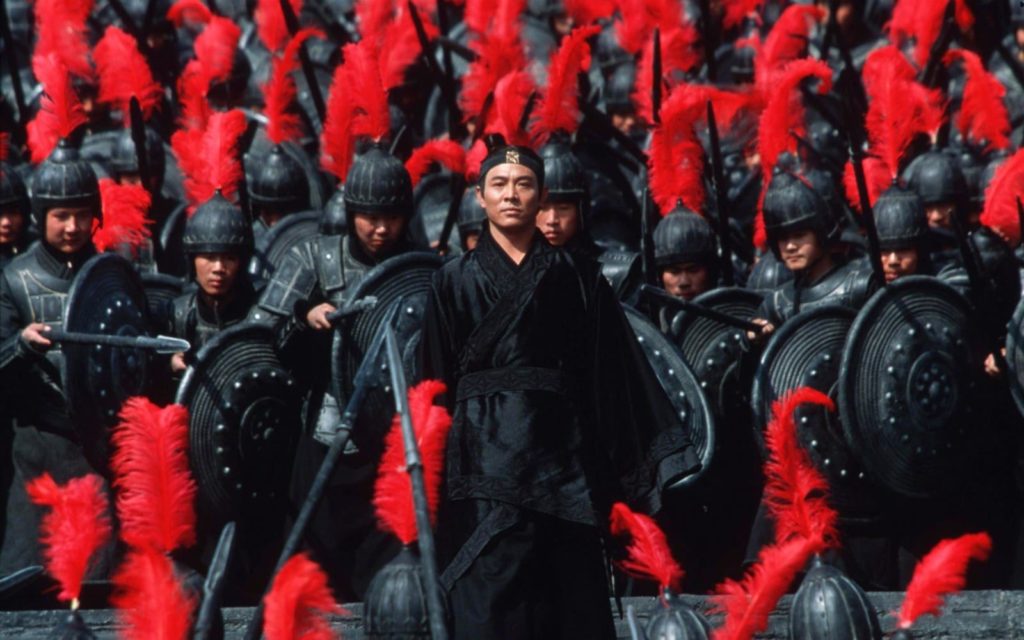
Zhang began his career in the 1980s with subtle and probing realist films, but he has more recently been compared by some critics to Leni Riefenstahl, not least for his design of the incomparable spectacle of the inaugural ceremony of the 2008 Beijing Olympic Games. Its precisely choreographed multitudes recalled the masses of Qin-era terracotta warriors. The aesthetic power of the ceremony was also its political power: the ability to move so many bodies in absolute concert, to mold human beings seamlessly into a collective. The Great Wall, the director’s latest venture and first English-language film, is his most costly foray yet into state-approved fantasy, as well as another major Sino-US cultural collaboration. A growing number of American films is now made with significant Chinese funding, and aims to succeed in the world’s second-largest movie market — though the government only authorizes a select few to play on Chinese screens, and Hollywood knows what Beijing’s censors like. The Chinese saved the world in the American disaster film 2012, and in Michael Bay’s most recent episode of the Transformers franchise, the American government bumbles while the Communist Party staves off disaster. Warcraft, last year’s video-game-inspired pageant of orcs and demons, was the latest Hollywood extravaganza made with China in mind; more than half of its $434 million gross came from the People’s Republic.
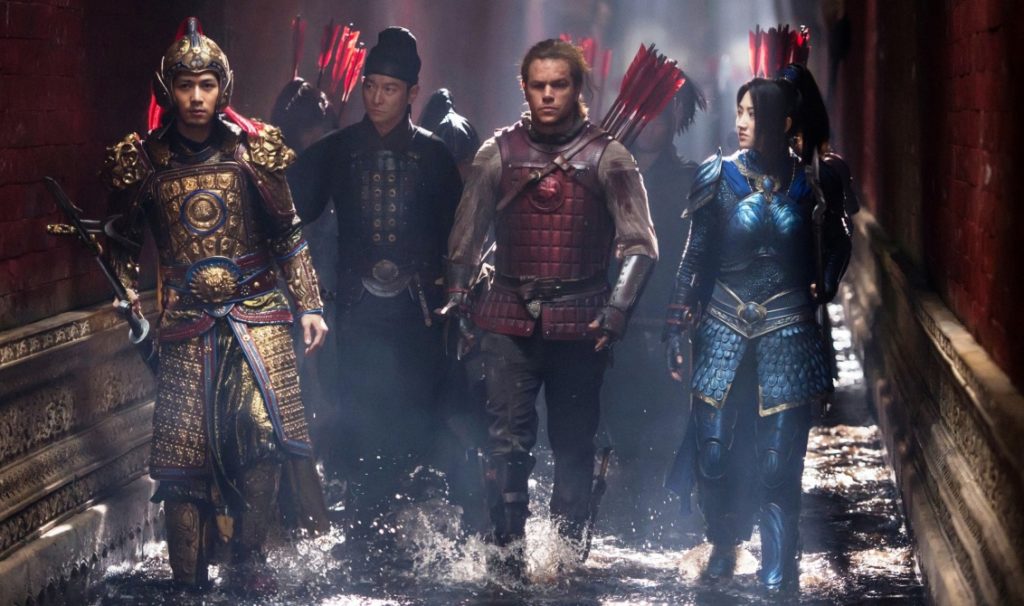
The Great Wall goes even further: it is the first proper China-US coproduction, funded by both the state-run China Film Group and the Hollywood studio Legendary Entertainment. (After filming was underway, Legendary was itself acquired by Dalian Wanda Group, China’s largest cinema operator.) Zhang’s budget for The Great Wall exceeded $150 million, and its extravagant production evokes the inventory of a Qin or Han emperor’s tomb: 13,140 costume pieces, 20,000 props, thousands of pieces of pottery. The film stars Matt Damon as a European mercenary who journeys to 11th-century China, hoping to steal gunpowder. He gets entangled in a cosmic battle against hordes of “Tao Tei,” lizard monsters that try every 60 years to breach the Great Wall and ravage the lands of mankind. By bashing and chopping enough reptiles, he befriends the haughty Commander Lin (played by the Chinese actress Jing Tian), whose bland paeans to duty and sacrifice make Damon’s character realize that where his prior battles were for “greed” and “gods,” here in China he has finally found “something worth fighting for.” Damon’s casting initially sparked howls of outrage and accusations of “whitewashing,” but his part was written for a European (he speaks in an odd, Scottish-inflected American drone) and, in any case, no actor should feel too aggrieved for losing out on such a wooden role in so risible a film.
There is, to be fair, one stunning set piece. Towards the film’s end, after the writhing Tao Tei breach the wall, Damon and Tian rush to the capital in a fleet of hot air balloons to save the vulnerable emperor. But aside from that explosive air show, the great disappointment of The Great Wall is not its dialogue — predictably flat and colorless for easy translation — nor its threadbare plot, but its visual dullness. Almost nowhere does one find the sensory pyrotechnics of Hero or the sumptuousness of Zhang’s follow-up, House of Flying Daggers (2004). The CGI-rendered Tao Tei make a featureless grey-green horde, but their human opponents, divided in various color-coded regiments, are not much more compelling, clambering insect-like over the wall. (Tian is an exception, leading a team of blue-clad aeronauts in a kind of balletic bungee jumping with spears.) One can’t help but feel that the size of the project overwhelmed Zhang, and he spurned moments of beauty for the spectacle of magnitude.
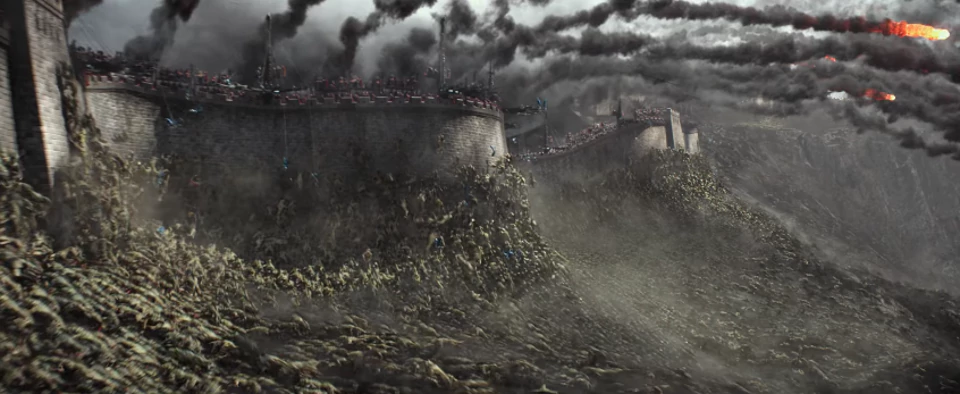
There’s another reason why The Great Wall feels so leaden. One simple appeal of a fantastical epic is how it takes us out of our own worlds and immerses us in the possibilities of another one. Zhang’s film does little of the sort, in part because it isn’t allowed to. The many strictures of China’s censors include prohibitions against any plot element that “disrupts the social order,” against showing ghosts, and against time travel; in sum, all material that suggests alternate realities and alternate histories. Yes, there is a teeming swarm of lizard monsters, but their villainy is entirely familiar, a nihilistic desire for destruction so shallow that it is unfathomable. The heroic state stands against the Tao Tei, and the Great Wall of the film protects the entire world (not just China) from the existential forces of chaos. Just as it guards the dangerous technology of gunpowder from untrustworthy outsiders, China is the custodian of global peace and harmony. In signing up with the local security forces, Damon becomes a hero of the status quo and a defender of the noble empire.
Of course, Chinese movies are hardly alone in conjuring the cult of the state and a virtuous, quasi-imperial sense of global purpose; Hollywood blockbusters have been doing this sort of thing for decades. But both the film and “Age of Empires” point to the limitations inherent to such large-scale Chinese-American collaborations. It’s telling that many of The Great Wall’s set pieces are designed for the inevitable video game that will follow the film. The values of the gaming arena — by far the most conservative realm of pop cultural production — are likely to animate future unions of Chinese and American cultural institutions: the emphasis on strength, on vanquishing the other, on safeguarding the unity of the nation, and on protecting the state.
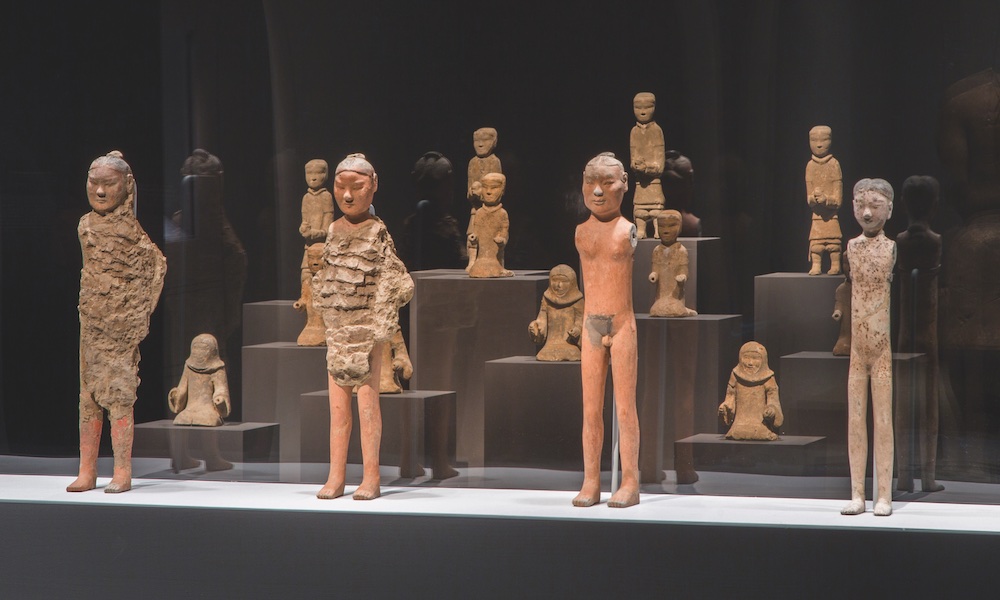
I wonder whether the curators of “Age of Empires” intentionally chose to name their exhibition after the popular computer game franchise that challenges players to build powerful kingdoms and armies, lording over industrious peasants and willing cannon-fodder soldiers. The curators were probably not clicking away at pixelated battalions while going about their work, but there is an important parallel between the exhibition and that game. In Age of Empires and similar video game series (the 30 million-copy selling Civilization franchise comes to mind), players steer a polity from the Stone Age to the Space Age. Their destination is fixed and pre-determined. And so it is as the Met: the signs and wonders of the Qin and Han-era past pave a fixed, unwavering road to modern-day Beijing. Unlike video game teleology, though, inevitability does not exist in life: no one knows whether modern, Communist China will rise to its desired empire status in the future, or whether some other force will cast it into the obscurities of many dynasties before.